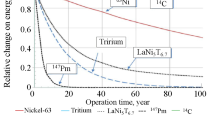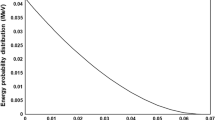Abstract
The radio-voltaic effect is investigated to be applied radioisotopic batteries in this work. The collection rates of the electron-hole pairs are 94 percent for the alpha particles emitted by239Pu source and 65 percent for the beta particles emitted by90Sr-90Y source. The maximum energy conversion efficiency got by the silicon element is about 16%. A prototype radioisotopic battery with147Pm beta sources is constructed. Its maximum short-circuit current and off voltage are about 2μ A and 190 mV respectively. The experimental data suggest that the life of the prototype battery may be more than three years.
Similar content being viewed by others
References
P. BROWN, Raum & Zeit Magazine, 1(1990)56.
R. WALKO, R. C. LINCOLN, W. E. BACA, Tritium-Field Betacells, Proc. of the 26th IECE Conf., Boston, 1991. Washington, D. C.: Dept. of Energy of USA.
T. WANG, B. ZHANG, Z. WANG, Nuclear Techniques, 17(1994)58.
Author information
Authors and Affiliations
Rights and permissions
About this article
Cite this article
Tieshan, W., Qiang, L., Baoguo, Z. et al. The radioisotopic battery based on radio-voltaic effect. Journal of Radioanalytical and Nuclear Chemistry, Articles 205, 141–145 (1996). https://doi.org/10.1007/BF02040560
Received:
Issue Date:
DOI: https://doi.org/10.1007/BF02040560




